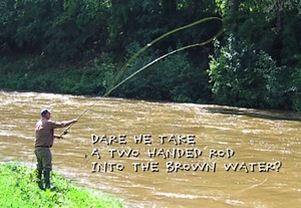 My New Year’s resolution was to learn how to Spey cast. Sure, I’m carrying too many pounds of flab, and drink far too much, but this resolution has a better’n average chance of me following through.
My New Year’s resolution was to learn how to Spey cast. Sure, I’m carrying too many pounds of flab, and drink far too much, but this resolution has a better’n average chance of me following through.
I thought it might be fun to return to those hideous days of clueless “Noob” – experiencing a mixture of fear and trepidation as you walk hesitantly to the counter hoping no one laughs outright at your halting, semi-understandable question.
Instinctively you look for the oldest guy there, figuring he’ll just sigh loudly and hand you what you need, versus the “young guns” who are enamored of technical detail and entirely oblivious of your struggle to follow their sermon.
I can pick up fragments of commentary; my tackle is “ghey” – ditto for the line I was thinking of buying and the antiquated click-pawl reel I was thinking of putting it on … I feel like someone’s wife hoping to score a Christmas present that hubby can actually use, and not knowing whether I’m being steered in the right direction, or how many hundreds of dollars is overkill.
Why is it that Spey casting has to set fly fishing back a hundred years?
All that pain and suffering to adopt a standard nomenclature, and based on someone’s whim – it’s thrown out the window.
My ambition was to start the long slow process of learning the physics and timing, just as we did years ago with a single hand rod. You get a nice serviceable outfit and beat the water to a frothy lather, in doing so, you learn a little about what feels good and what doesn’t.
Being methodical I started with the Internet – watching countless YouTube videos and gleaning what I could from web pages and their commentary.
Things started to sour when I discovered rod vendors make two handed spey rods for #7/8 or #5/6 – and line merchants make spey fly lines in #6/7/8 or #7/8/9. As the rod merchants are in the same boat – they can’t recommend a line for the rod they’re selling – do you want a “light” #8 (6/7/8) or a “heavy” #8 (7/8/9) ?
Most rod makers list a grain range for the line best suited, and many line vendors don’t list grain weights on their packaging or website.
Traditional fly lines are weighed by the sum of the first 30 feet, and Spey lines can be sold by the first 50 of belly, or first 70 feet. Add Skagit, Scandinavian, and regular spey into long belly, short head, and multiple tips – and you can’t help winding up with a short fuse.
Searching for someone that seems to have sorted it all out leads you through a miasma of forums and bulletin boards on the subject. Within the first half dozen posts someone is calling someone else “ghey” – and you’re not sure whether the guy called “BashMomsHead” or the other fellow, “MyDickInTrout” is correct.
I think neither, which really adds to the quandary.
Multiple sinktip configurations abound; some require the purchase of running line, and some have it integrated, many of the online fly shop descriptions are unclear as to which you’re buying, and all have multiple 15′ or 20′ tips to add varying sink rates. At $150 per multi-tip line, you’re still wondering whether the light #8 or the heavy flavor is best – and throwing a lot of money at a hunch.
… and whose bright idea was it to call a sinktip a “polyleader?”
The AFTMA standards were developed so we wouldn’t have to play this silly “vendor specific” game, and we could buy any line labeled an “8” and feel confident we got something that works.
If you’re like me – with no casting club available or fishing buddy that is practiced – you’ve got a better than average chance of putting the wrong line on a rod and wondering why everyone else likes the style – when your rod feels slow and impotent when cast.
The whole “fit and feel” issue dominates the forums, with every third question being “what should I use with my ..” – so I’m in good company. I’m just disappointed that every other response involves someone’s mother – making the learning process painstaking slow as chaff is sorted from wheat, and opinions are isolated from ego.
I’m sure most of the issue lies in the original lines being hand crafted, assembled in garages out of chunks of other lines and leadcore, but it’s odd the mainstream rod and line vendors haven’t taken the initiative and evolved something resembling a standard.
I tried my first cast in anger last week, and it was a total disaster. I’d managed to find a brand new Echo Classic #6/7 on eBay for $130, and paired it with an Orvis Spey Wonderline that was on sale for $25. Orvis makes Spey lines in single sizes, the rod is listed for multiple sizes, and the answers on their customer service forum makes me feel somewhat vindicated.
Q: Please inform on the length end weight of the body (incl. tips) of your multitip speyline # 6/7, and #7/8?
A: Hi there. I’m Crystal from Orvis Customer Service. Since no one has answered your question yet, I did a little research for you, and here’s what I found out:
For the #6/7 weight the total length is going to be 110′ and for the #7/8 weight the total length is going to be 120′.
Naturally Crystal failed to answer the weight question, after searching their site and the Internet, it appears no one knows.
After my first outing I figured the Orvis line was woefully underweight, as even roll casting wouldn’t work. The beauty of having an abundance of old sinking lines means I can cut a chunk out of one and add it – clipping additional off until I have something that “feels” like it is the proper weight.
Spey lines with their multi-tip configuration run $150 each, and if you squawked at the Scientific Angler Sharkskin price, you can see why I’m being tentative, with the hideous price of the equipment and the lack of standards, I’d rather make a $30 mistake.
There’s little question that mastery of this style will allow any angler to add a couple tricks to his repertoire, especially if the space behind him is limited.
I’ll know how much help it’ll be once I can get a cast further than 20′ – which is my current personal best.


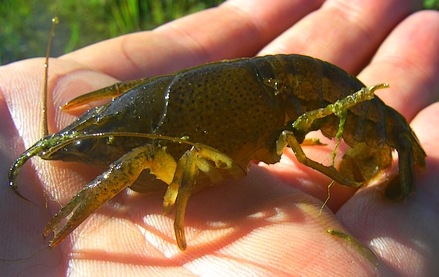



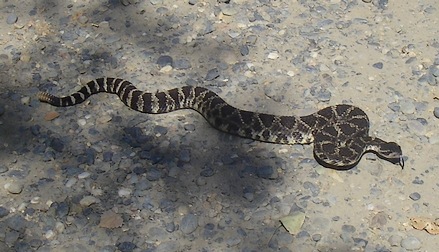
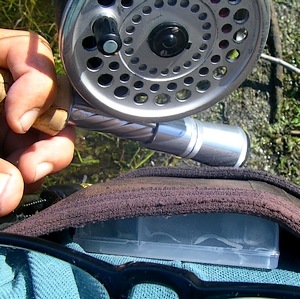 I’ve got dozens of flies in a dozen colors, but this one will do just fine.
I’ve got dozens of flies in a dozen colors, but this one will do just fine. The first fellow was towing a lure that looked like a plucked Olive chicken carcass – minus saran wrap and foam plate. I says, “what’s your buddy throwing – a pizza?”
The first fellow was towing a lure that looked like a plucked Olive chicken carcass – minus saran wrap and foam plate. I says, “what’s your buddy throwing – a pizza?”

 My first blush would be some form of drake – two tails, pronounced mottle on all extremities – and large enough to make you snap off that anemic #16 and reach for the box containing meat…
My first blush would be some form of drake – two tails, pronounced mottle on all extremities – and large enough to make you snap off that anemic #16 and reach for the box containing meat…

 The excited catcalls and snarling gears suggested I’d better hurry if I wanted to watch the kid get stuck.
The excited catcalls and snarling gears suggested I’d better hurry if I wanted to watch the kid get stuck.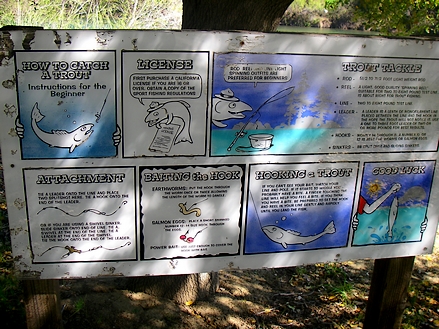
 My New Year’s resolution was to learn how to Spey cast. Sure, I’m carrying too many pounds of flab, and drink far too much, but this resolution has a better’n average chance of me following through.
My New Year’s resolution was to learn how to Spey cast. Sure, I’m carrying too many pounds of flab, and drink far too much, but this resolution has a better’n average chance of me following through.
 It’s not that we can’t appreciate beauty, it’s only that we’ve been here so many times – knowing that if everything falls into place, the fish will be absent.
It’s not that we can’t appreciate beauty, it’s only that we’ve been here so many times – knowing that if everything falls into place, the fish will be absent.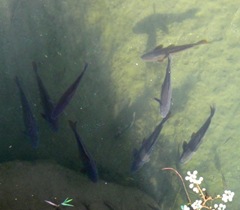 I tossed everything I had, every oddball experimental and all the proven patterns; weighted, unweighted, dead drift, and stripped, and there was naught to show for my industry.
I tossed everything I had, every oddball experimental and all the proven patterns; weighted, unweighted, dead drift, and stripped, and there was naught to show for my industry.